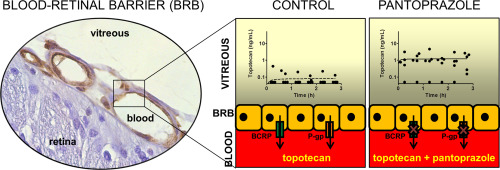Journal of Controlled Release ( IF 10.5 ) Pub Date : 2017-08-19 , DOI: 10.1016/j.jconrel.2017.08.018 Guillem Pascual-Pasto , Nagore G. Olaciregui , Javier A.W. Opezzo , Helena Castillo-Ecija , Maria Cuadrado-Vilanova , Sonia Paco , Ezequiel M. Rivero , Monica Vila-Ubach , Camilo A. Restrepo-Perdomo , Montserrat Torrebadell , Mariona Suñol , Paula Schaiquevich , Jaume Mora , Guillermo F. Bramuglia , Guillermo L. Chantada , Angel M. Carcaboso

|
Treatment of retinoblastoma -a pediatric cancer of the developing retina- might benefit from strategies to inhibit the blood-retinal barrier (BRB). The potent anticancer agent topotecan is a substrate of efflux transporters BCRP and P-gp, which are expressed at the BRB to restrict vitreous and retinal distribution of xenobiotics. In this work we have studied vitreous and retinal distribution, tumor accumulation and antitumor activity of topotecan, using pantoprazole as inhibitor of BCRP and P-gp. We used rabbit and mouse eyes as BRB models and patient-derived xenografts as retinoblastoma models. To validate the rabbit BRB model we stained BCRP and P-gp in the retinal vessels. Using intravitreous microdialysis we showed that the penetration of the rabbit vitreous by lactone topotecan increased significantly upon concomitant administration of pantoprazole (P = 0.0285). Pantoprazole also increased topotecan penetration of the mouse vitreous, measured as the vitreous-to-plasma topotecan concentration ratio at the steady state (P = 0.0246). Pantoprazole increased topotecan antitumor efficacy and intracellular penetration in retinoblastoma in vitro, but did not enhance intratumor drug distribution and survival in mice bearing the intraocular human tumor HSJD-RBT-2. Anatomical differences with the clinical setting likely limited our in vivo study, since xenografts were poorly vascularized masses that loaded most of the vitreous compartment. We conclude that pharmacological modulation of the BRB is feasible, enhances anticancer drug distribution into the vitreous and might have clinical implications in retinoblastoma.
Chemical compounds included in this manuscript
Topotecan (PubChem CID: 60700)
Pantoprazole sodium (PubChem CID: 15008962)
中文翻译:

通过抑制血视网膜屏障,增加向玻璃体的化学疗法递送
视网膜母细胞瘤(一种发展中的视网膜儿科癌症)的治疗可能受益于抑制血视网膜屏障(BRB)的策略。有效的抗癌药拓扑替康是外排转运蛋白BCRP和P-gp的底物,它们在BRB上表达,以限制异源玻璃体和视网膜的分布。在这项工作中,我们研究了使用pan托拉唑作为BCRP和P-gp抑制剂的托泊替康的玻璃体和视网膜分布,肿瘤蓄积和抗肿瘤活性。我们将兔眼和小鼠眼用作BRB模型,将患者来源的异种移植物用作成视网膜细胞瘤模型。为了验证兔BRB模型,我们在视网膜血管中对BCRP和P-gp进行了染色。通过玻璃体内微透析,我们显示内酯托泊替康对兔玻璃体的渗透作用在同时使用pan托拉唑时显着增加(P = 0.0285)。以稳态时玻璃体与血浆中拓扑替康的浓度比(P = 0.0246)来衡量,托拉唑还可以提高小鼠玻璃体的拓扑替康渗透率。top托拉唑增强视网膜母细胞瘤拓扑替康的抗肿瘤功效和细胞内渗透在体外,但并没有增强携带眼内人类肿瘤HSJD-RBT-2的小鼠体内肿瘤药物的分布和存活。由于异种移植物是血管化不良的肿块,大部分玻璃体腔被装载,因此与临床环境的解剖学差异可能会限制我们的体内研究。我们得出结论,BRB的药理学调节是可行的,可增强抗癌药向玻璃体内的分布,并可能在视网膜母细胞瘤中具有临床意义。
本手稿中包含的化合物
拓扑替康(PubChem CID:60700)
top托拉唑钠(PubChem CID:15008962)










































 京公网安备 11010802027423号
京公网安备 11010802027423号